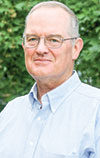Being able to measure forage mass available for grazing is needed for pasture budgeting. Forage height is one way to estimate forage mass when calibrated for the stand being grazed.
There are several ways for measuring forage height. These include pasture sticks, plate meters and newer devices based on ultrasound (think sonar) and light penetration or reflection. New systems being developed add multispectral light reflection to estimate forage quality.
Pasture stick/ruler
The simplest and least expensive tool is the pasture stick (Photo 1).
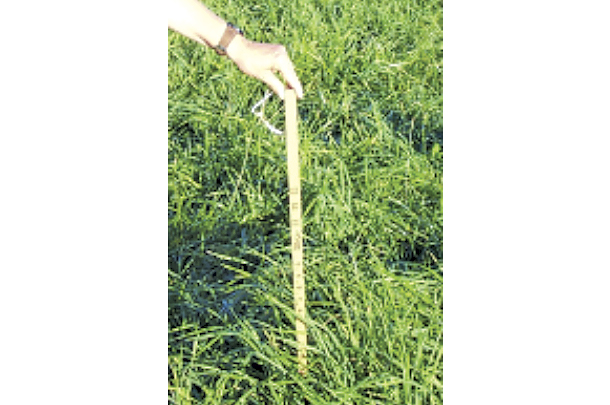
The ruler is low-cost ($5 per stick) but is highly subjective when used to measure pasture height. Pasture sticks require a relatively high labor cost for the manager walking each pasture, writing down measurements and calculating average height. State NRCS and extension services have developed their own pasture sticks with local recommendations on how to use them to improve grazing management.
Plate meters
Plate meters reduce the subjective measurement of pasture height. One of the earliest plate meter designs was the falling plate meter. This consisted of a metal plate dropped from a defined height, the plates’ resting height above the ground being the measure of sward-compressed height. This was modified into what is now call the resting plate meter, where the plate is placed gently on the sward, and the resting height above ground is the sward-compressed height.
In on-farm trials, using the plate as a resting plate meter provided less variability in measuring pasture height than did dropping the plate from a given height. This resting plate meter (previously referred to as a falling plate meter) was developed for farmers in a Northeast, multistate grazing program conducted by Seneca Trail RC&D out of Franklinville, New York (Photo 2).
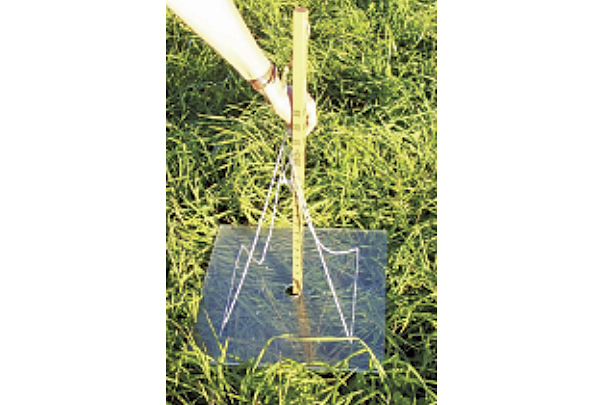
When made in volume by an FFA chapter, these acrylic plastic plate meters cost $36 per plate in 2018. The resting plate meter has a similar labor requirement as the pasture stick for walking the pastures, writing down measurements and calculating the average. Calculating the average is reduced by using a free phone app (such as “Stats Calculator Free”) as the user walks the pasture.
Another option is a rising plate meter (Photo 3).
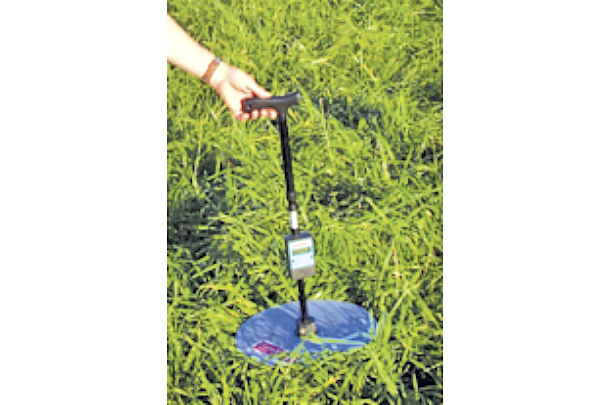
These are called rising plate meters since the plate is placed on the pasture and the handle is pushed down to ground level, forcing the plate to rise up the center shaft as a cogged wheel measures the height of the plate above the ground. These meters come with mechanical or electrical counters, phone apps and GPS recording depending on the model.
Electronic models provide for downloading data to a computer for summary and storage. Rising plate meters remove the subjectivity of measuring pasture height. They can give biased readings when the plate is not put down vertically on the sward or when the unit is jabbed onto the sward as the user walks rapidly across a paddock. Rising plate meters are more expensive ($350 to $750) but provide added convenience.
Capacitance probe
Another technology for measuring pasture mass is the electronic pasture probe (Photo 4).
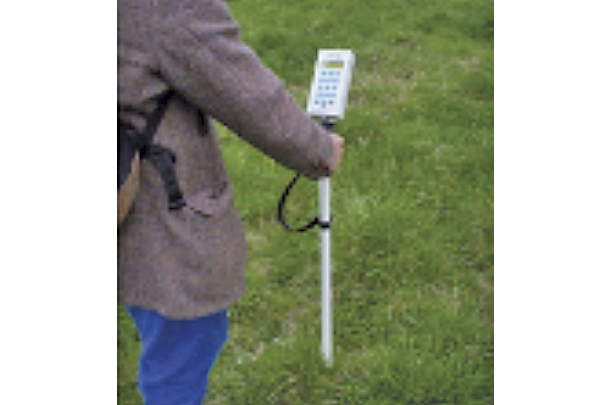
This unit measures the electrical capacitance of a sward’s height and density, converting capacitance to forage mass using proprietary calibrations. The GrassMaster Pro pasture meter ($1980) is one example of a capacitance meter that has a data recorder with data downloadable to a computer.
ATV-mounted pasture meters
For those wanting to drive across the pasture, there are ATV-mountable or towable pasture meters. An ATV-mounted rising plate meter is produced by Jenquip. Another is the pasture sled by C-DAX which is pulled behind a four-wheeler. This unit uses infrared lights to measure height. It is also being developed as a robotic unit that will drive itself across the pasture. In development are other ATV-mounted units using ultrasonic sensors to measure height.
Future ATV- and drone-mounted meters
Other technologies are being developed and, in some cases, are already available. These include the combination of ultrasonic (sonar as used in car backup sensors), LIDAR (light detection and ranging, lasers) and multiband light sensors including near-infrared (NIR). The multiband light sensors are used to calculate indices (NDVI, normalized difference vegetation index) for evaluating plant health and forage nutritive value. These units are mounted on ATVs or aerial drones.
Tools require calibration and can be cross-calibrated
Any system used for estimating forage mass from height or other technology must be calibrated against clipped forage mass. Commercial calibrations may be proprietary. Calibrations provided by extension services and NRCS are generally open calibrations.
Cross-calibrations between ruler height (RHt, inches) and plate meter heights or between resting plate meter (CHt, inches) and rising plate meters (FT, centimeters) allow the use of a given calibration across devices. The definition of ruler height used here is the height of the tallest leaf in its natural position within 4 inches of the ruler. Simple cross-calibrations for these devices are:
- CHt inch = 0.6 RHt inch
- FT centimeter = 2.1 CHt inches
- FT inch = 0.8 CHt inch
These rules show that the resting plate meter causes the compressed sward height to be 0.6 times the ruler height (tallest leaves within 4 inches of the ruler) and that the rising plate meter compresses the sward to 0.8 times the compressed height of the resting plate meter, due to its heavier weight or the pushing of the handle down through the plate.
Pasture sticks and plate meters are reliable tools for measuring pasture height and estimating forage mass. The tools are relatively inexpensive and require walking pastures to take the measurements and writing down the numbers and calculating the averages. As electronics are added, tool price goes up and ease of data handling improves.
Walking pastures has an advantage in itself in that the manager is able to observe forage health and animal grazing patterns across pastures. Newer technologies will enable automation of pasture forage mass and add forage quality measurements. As technologies improve and are adopted, prices will come down. The ability to measure pasture forage mass and use it to improve grazing is vital to improving pasture management and animal performance.
Company and brand names presented here are for displaying available technology and are not an endorsement or recommendation.
For more information on pasture height measurement, see the article “Measuring and budgeting pasture availability,” Progressive Forage April 2019. ![]()
PHOTO 1: A pasture stick is being used to measure forage height with forage mass estimated using regional, multispecies calibrations.
PHOTO 2: A resting plate meter is being used to measure pasture height with forage mass estimated using regional multispecies calibrations.
PHOTO 3: A commercial rising plate meter is being used to measure pasture height with forage mass estimated using proprietary or locally produced calibrations.
PHOTO 4: A capacitance probe is being used to measure pasture capacitance and estimate forage mass using proprietary calibration equations. Photos provided by Edward Rayburn.

-
Edward Rayburn
- Forage Agronomist
- West Virginia University
- Email Edward Rayburn
